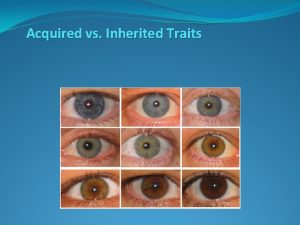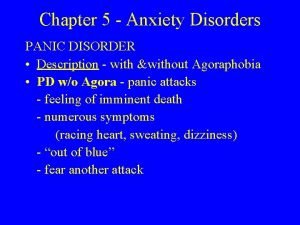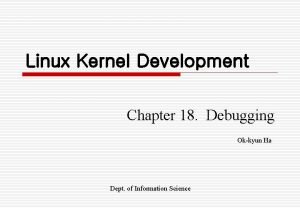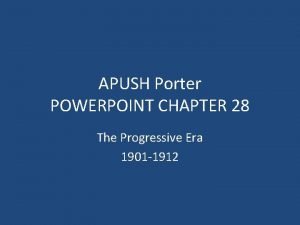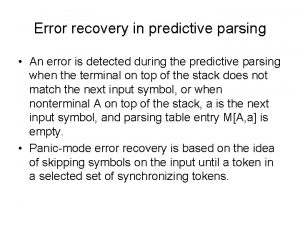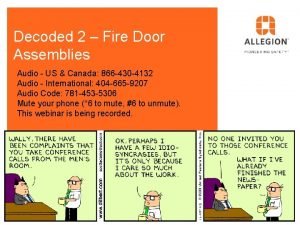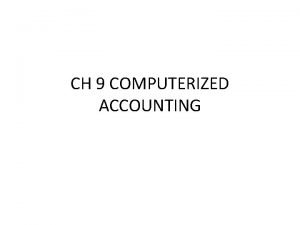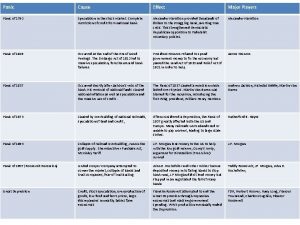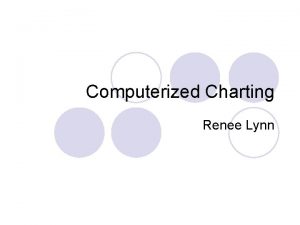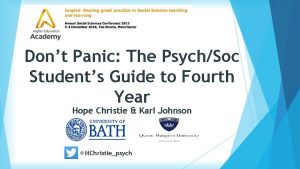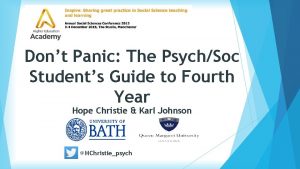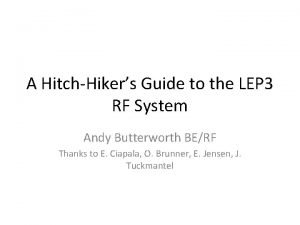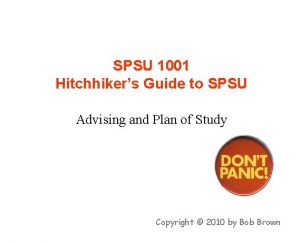Dont Panic A Hitchhikers Guide to Computerized Economic




















- Slides: 20

Don’t Panic! A Hitchhiker’s Guide to Computerized Economic Teaching Experiments

by Dieter Balkenborg Todd Kaplan Tim Miller

Why Experiments? They are a fun way to learn and to teach! n Complements standard methods n Helps students with low math skills n Enhances credibility of our science n Puts us on the test n

Why Using Computerized Experiments n n n “Free ride” on existing resources Little preparation speedy Automatic tabulation of results Some are difficult to do hand-run Limitations: n n n Class size Computing facilities Time constraints

FEELE; veconlab, econport Three new names to learn n Easy to “google” for n We will spend some time on each site and learn how to use them n We start with a visit to http: //en. wikiversity. org/wiki/Economic_ Classroom_Experiments Please add your experience! n

On “our” wikiversity site 1 Why use experiments in teaching economics 2 List of Experiments 3 Hints for running economic classroom experiments 4 Useful Links and Related Literature … Now, let’s google for “FEELE”

FEELE Laboratory is mainly a research lab so look for: “Access our Website of Teaching Experiments” View list of experiments (short descriptions) Experimenter access (that’s soon you) Participant access (enter now) n

You are invited to participate in my experiment! Experiments are an experience good! 1. Enter participant access 2. Register for my experiment (no login yet) 3. You need the access code “dgb 1 -dee” which identifies my experiment 4. Read the instructions 5. Good luck!

Sample result: Bertrand Two Firms Fixed Partners Random Partners Five Firms Random Partners “I “Some learnt that collusion can take place in a people are undercutting bastards!!! competitive market even any actual Seriously though, it waswithout interesting to see how the meeting place between the two parties. ” theorytaking is shown in practise. ”

Now register as experimenter Code word: deadsea n Next time login with your assigned password (your initials + number) and password (4 -digit number e-mailed to you, KEEP ACCESSIBLE) n

Set up experiment New, different suffix for each session you run, your username + suffix = access code for students n Name: Bertrand complements, DEE n Select type of experiment from dropdown box (Bertrand) n

Add session Press “add session” n View instructions n Configure – initially make minimal adjustments: complementary, number of subjects, number of rounds, number of players, fixed partners n View instructions n (Run session, View and save results) n

Veconlab (Charlie Holt) n n FEELE copies this design Similar registration procedure and setting up of experiment One website for students, one for participants Don’t miss the bubble experiment!!!!!


Testing a new experiment n I demonstrate here how I can learn about a new experiment by 1. Setting it up with a minimal number of participants 2. Open a new window for each participant and register as participant 3. Play against myself by switching between the open windows (use ALT-TAB to switch) 4. See the results in the instructor’s window

Charlie Holt U. of Virginia Creator of Veconlab n Has written textbook on teaching experiments. n Book explains both handrun and computerized

Econ. Port (James Cox) The Best for: 1. Vernon Smith’s double auction (graphs! Adding excise taxes!) 2. Charlie Plott’s asset market 3. General normal form games 4. Extensive games Also: handbook, resources

How to use Econ. Port 1 1. 2. 3. Java must be installed, testing necessary! First: Configurations: ADD A NEW GROUP (No changes in group “public configurations”) DO NOT CREATE NEW CONFIGURATION YOURSELF!!

How to use Econ. Port 2 1. 2. 3. 4. 5. 6. Now go via tab to “Experiments” Choose documentation, e. g. on marketlink or check the teaching module sections. In the documentation you find standard configurations, e. g. for excise taxes in a competitive market, which you can add to your newly created configuration group. This configuration can then be edited. Create a new group in your “experiments” There you add the configuration as often as you want to run a new session. Per group you can only have one experiment at a time running. It is a great software!!!

Thanks n n Thank you for your attendance, I hope we got you interested For short questions you can e-mail me on d. g. balkenborg@ex. ac. uk (have teaching experiment in the title!) Possibility of hands-on sessions in UK universities Thanks to the economic network for continuous support + Charlie Holt + James Cox
 Acquired trait
Acquired trait Dont laugh at me dont call me names
Dont laugh at me dont call me names Dont ask dont tell political cartoon
Dont ask dont tell political cartoon Economic growth vs economic development
Economic growth vs economic development Growth and development conclusion
Growth and development conclusion Lesson 2 our economic choices
Lesson 2 our economic choices Don't panic
Don't panic Rollin 90 crip oklahoma
Rollin 90 crip oklahoma Definition of deviance amplification
Definition of deviance amplification Hyperventilation
Hyperventilation Classical conditioning panic disorder
Classical conditioning panic disorder Debugger message panic
Debugger message panic Panic mode recovery in lexical analysis
Panic mode recovery in lexical analysis Panic seized the writer passive voice
Panic seized the writer passive voice Panic of 1907 apush definition
Panic of 1907 apush definition Error recovery in top down parser
Error recovery in top down parser Panic exit hardware
Panic exit hardware Why did the athenians sail to nearby islands in panic?
Why did the athenians sail to nearby islands in panic? Faktor pembentuk kelompok sosial
Faktor pembentuk kelompok sosial Alen panić
Alen panić Panic seized the writer passive voice
Panic seized the writer passive voice
